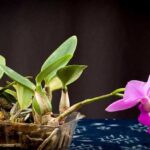The maxillaria picta is one of the most controversial orchids among the orchid species.
It can be found in the following countries:
- Brazil (southern region, found at altitudes ranging from 200 to 600 meters – 656 to 1968 feet)
- Argentina
If you own this orchid or are thinking of buying it, keep reading this article because here you will learn everything about its curiosities and how to cultivate it.
Learn How to Achieve Super Blooms on Your Orchids
🛑 If you love orchids and you're tired of not being able to make them bloom...
Then, know that thousands of beginner growers are achieving beautiful flowers on their orchids by following this method.
Click the button below to have beautiful orchids with show-worthy flowers every year. ⤵
Characteristics
This is an epiphytic orchid described in 1832 by William Hocker.
But since then, it has been through several controversies.
It has been classified in several ways:
- Maxillaria acutipetala
- Maxillaria kreysigii
So in 2007, it was changed genera, and now its correct name is Brasiliorchis picta.
Curiosity: picta means painted; it was named this because of its spots on the petals and sepals.
Flowers
Almost every orchid has its time to shine in blooming, and in the case of maxillaria picta, this is no different.
Below are the main characteristics of its flowering:
- It usually blooms in June.
- Its flowers are highly perfumed, with a scent reminiscent of honey, a characteristic that made it famous worldwide.
- Its floral stems produce one flower.
- The flowers measure between 2.5 to 5 cm (1 to 2 inches) in length.
- The blooming lasts an average of 15 to 25 days.
Cultivation of Maxillaria Picta
Every orchid has some needs that must be provided; if not, they won’t be healthy.
To cultivate your maxillaria picta (Brasiliorchis picta), follow the steps below:
- Plant it in pots or trees, never in the soil.
- Provide direct sunlight in regions with weaker sun or 30% shading if the sun is strong.
- Use a potting mix with good drainage (usually potting mixes for epiphytic orchids are excellent for it).
- Avoid replanting; this is an orchid that doesn’t like to be replanted, so be very careful.
- Water at the roots, never on the leaves.
- Do not let the temperature exceed 30°C (86°F).
To learn more about cultivating this and other orchids, see our article how to care for orchids.
Conclusion – Brasiliorchis Picta
This was a quick guide on how to cultivate this orchid.
If you want to learn more about orchids, I recommend you read the articles below.
- Spots on Orchid Leaves: Causes and How to Treat
- How to Make an Orchid Bloom [Beginner’s Guide]
- Dendrobium Orchid Care
- Vanda Orchids Care
Now I want you to participate.
Comment below on how your cultivation is going and what tip you would add to this article.
I’m waiting for your opinion.














![How to Make an Orchid Bloom – featured image How to Make an Orchid Bloom [Beginner's Guide]](https://planticulous.com/wp-content/uploads/2023/10/How-to-Make-an-Orchid-Bloom-featured-image-150x150.jpeg)

